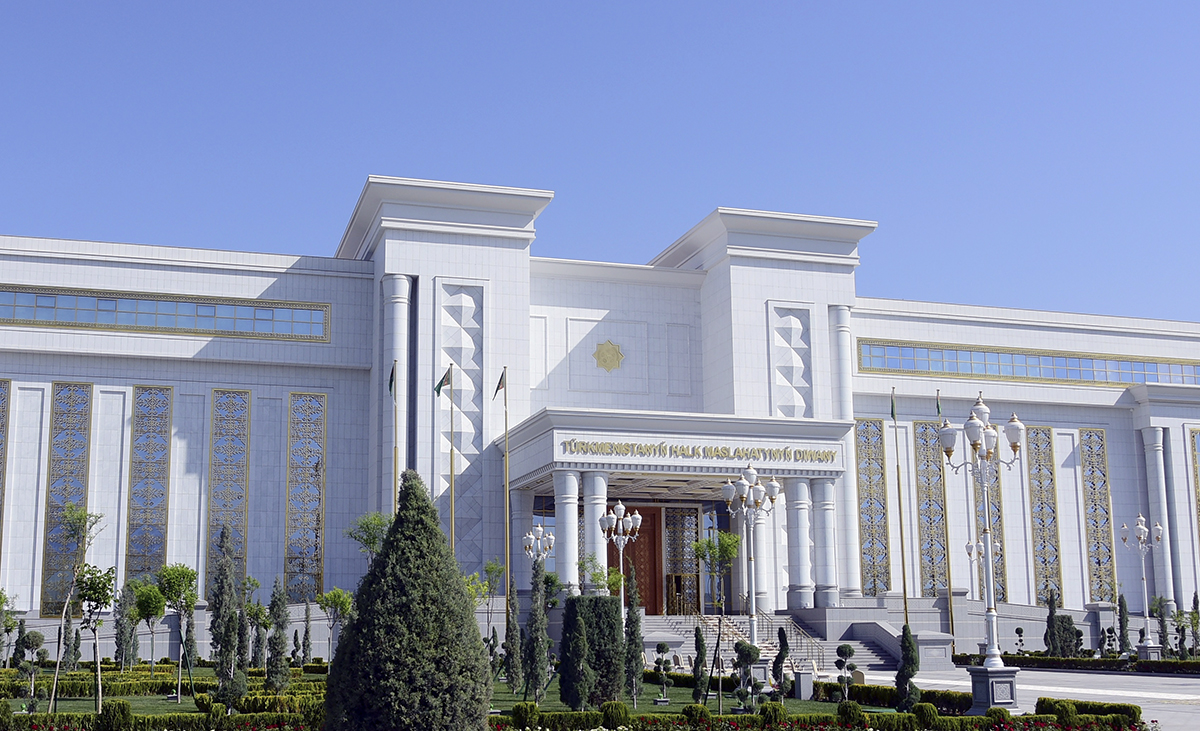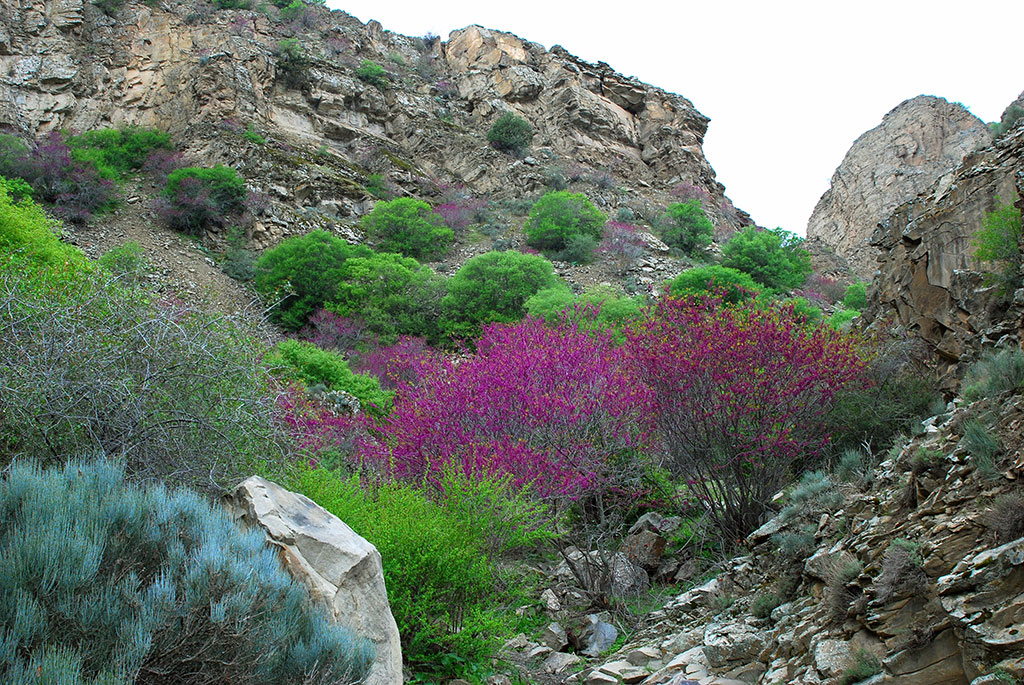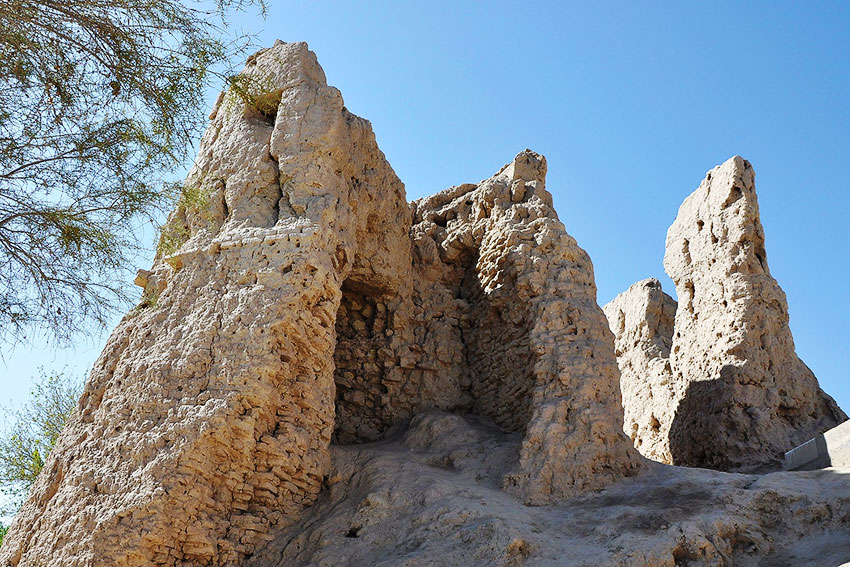For many foreign visitors the gateway to the country is the capital of Turkmenistan, which is one of the most beautiful cities in Asia. Ashgabat is the largest business and cultural centre and, of course, tourist destination with the constellation of office buildings, museums, theatres, recreation areas, parks and numerous fountain complexes of unique architectural design.
From the Turkmen capital the guests travel along the tourist route. Let’s imagine that we are sitting in a comfortable bus which has gone on a journey around Turkmenistan. Our trip begins with a visit to the ancient land of Ahal.

One of the major historical and cultural sites inscribed in the UNESCO World Heritage List is Ancient Nisa. The ruins of the ancient cities of Old and New Nisa lie in the picturesque valley near Baghir settlement located 18 kilometres from Ashgabat. These ruins are a reminder of the Parthian Empire that competed with Great Rome for supremacy in the ancient world by military strength and cultural development. It lied on the major routes of the Great Silk Road.

The period of the might and flourishing of Nisa covers II-I centuries B.C. In the antiquity and the Middle Ages travellers wrote that this city was big and beautiful, abundant in water and amenities of life. In the old days there were palaces and temples, treasures of the Parthian kings. The city lived its regular life, crafts and arts flourished there, trade was promoted, its citizens celebrated weddings and visited friends, sew grain, cultivated gardens and brought up children.
In Nisa the archaeologists found the evidence of the ancient civilization such as coins, priceless ivory rhytons, dishware, pieces of gold and silver jewellery and marble statues, rare specimens of the Parthian wall paintings and stone architectural decorations. These artefacts are exhibited nowadays in the Main Museum of Turkmenistan.

Our journey continues in the Saparmurat Haji mosque. It was built on the territory of the Geokdepe fortress that is sacred for the Turkmen nation. Over a hundred years ago our ancestors rose in arms to defend their freedom, their right to live and follow the national traditions and customs. The present generation of the Turkmen people reveres the memory of the fallen heroes who sacrificed the lives for independence of the homeland. This mosque is an element of the memorial complex immortalizing the heroic deed of the defenders of the Geokdepe fortress.
The unique creation of nature is the underground lake in the Kov-Ata cave that is rightfully called the eighth wonder of the world. The cave is located 100 kilometres from Ashgabat. The lake lies at the depth of 60 metres from the entrance to the cave. The long stairs with lighting lead to the lake. Water in the lake is saturated with hydrogen sulphide and has the healing properties. Water temperature in the lake varies from 33 to 38 degrees. The lake, which is one of the largest underground lakes in the world, is 80 metres long, 30 metres wide and 16 metres deep. In the cave tourists will learn one of the interesting legends about the origin of this wonder of nature and swim in the lake, the more so because water temperature is the same all year round. Kov-Ata as a wonderful natural site is protected by the Government of Turkmenistan.

Then the route leads to the ancient settlement Bagabad (present day Anau) located 12 kilometres to the east of Ashgabat. Its major sight is the magnificent ruins of the Sheikh Seyit Jemal Ad-din Mosque which crashed down during the earthquake in October 1948. This mosque built in the mid of the 16th century is also known as the House of Beauty. It is the monumental construction with the central hall and the cupola. The walls were covered with beautiful mosaic ornaments. The Anau mosque rightfully belongs to the architectural masterpieces created by oriental craftsmen.
Not far away from the mosque are the well-known mounds of Anau that are the archaeological relics of the ancient agricultural civilizations which existed over 7,000 years ago. It is there that the American expedition led by Raphael Pumpelly discovered several of grains ak bugday wheat which is one of the earliest agricultural crops in the world, over a hundred years ago. The Ak Bugday Museum, which presents many artefacts and archaeological finds testifying to workmanship of Turkmen farmers, was opened to mark the 100th anniversary of this event.

The tourist route lays to Kaahka Etrap which is famous for the mausoleum of Abu Seyit Abul Haira who is widely known as Meana Baba. The mausoleum was built in the medieval town of Meyhena in the 11th century when the state of the Turkmen Seljuk flourished. Abu Seyit Abul Haira is known as a historical personality who played in an outstanding role in political and spiritual life of medieval Khorasan.
The Abu Fazl Mausoleum known in the region as Serahs-Baba is one of the cultural monuments in Ahal. It was built in the 11th century in the vicinities of Serahs on the tomb of a well-known Muslim mystic. The building consists of an only square room. Its side dimension is 10.2 metres. The compositional simplicity, proportional clarity and outstanding masonry technique places this construction among the outstanding medieval architectural monuments of Turkmenistan.
Tourists travelling across Ahal can visit the Kopetdag State Reserve. The mountain slopes are covered with woodlands of juniper, or archa how it is called in Turkmenistan. From ancient times juniper forests are known for their healing air. Rare animal spices including leopard or ounce, feathered giants such as black griffon, griffon vulture, bearded vulture and very small Iranian chiffchaff weighing a few grams, peregrine, missel, mountain colley, coalmouse, common buzzard and many others inhabit the territory of the national park.
Turkmenistan, each of its regions is rich in unique historical, cultural, architectural monuments and natural sites.
From the Turkmen capital the guests travel along the tourist route. Let’s imagine that we are sitting in a comfortable bus which has gone on a journey around Turkmenistan. Our trip begins with a visit to the ancient land of Ahal.

One of the major historical and cultural sites inscribed in the UNESCO World Heritage List is Ancient Nisa. The ruins of the ancient cities of Old and New Nisa lie in the picturesque valley near Baghir settlement located 18 kilometres from Ashgabat. These ruins are a reminder of the Parthian Empire that competed with Great Rome for supremacy in the ancient world by military strength and cultural development. It lied on the major routes of the Great Silk Road.

The period of the might and flourishing of Nisa covers II-I centuries B.C. In the antiquity and the Middle Ages travellers wrote that this city was big and beautiful, abundant in water and amenities of life. In the old days there were palaces and temples, treasures of the Parthian kings. The city lived its regular life, crafts and arts flourished there, trade was promoted, its citizens celebrated weddings and visited friends, sew grain, cultivated gardens and brought up children.
In Nisa the archaeologists found the evidence of the ancient civilization such as coins, priceless ivory rhytons, dishware, pieces of gold and silver jewellery and marble statues, rare specimens of the Parthian wall paintings and stone architectural decorations. These artefacts are exhibited nowadays in the Main Museum of Turkmenistan.

Our journey continues in the Saparmurat Haji mosque. It was built on the territory of the Geokdepe fortress that is sacred for the Turkmen nation. Over a hundred years ago our ancestors rose in arms to defend their freedom, their right to live and follow the national traditions and customs. The present generation of the Turkmen people reveres the memory of the fallen heroes who sacrificed the lives for independence of the homeland. This mosque is an element of the memorial complex immortalizing the heroic deed of the defenders of the Geokdepe fortress.
The unique creation of nature is the underground lake in the Kov-Ata cave that is rightfully called the eighth wonder of the world. The cave is located 100 kilometres from Ashgabat. The lake lies at the depth of 60 metres from the entrance to the cave. The long stairs with lighting lead to the lake. Water in the lake is saturated with hydrogen sulphide and has the healing properties. Water temperature in the lake varies from 33 to 38 degrees. The lake, which is one of the largest underground lakes in the world, is 80 metres long, 30 metres wide and 16 metres deep. In the cave tourists will learn one of the interesting legends about the origin of this wonder of nature and swim in the lake, the more so because water temperature is the same all year round. Kov-Ata as a wonderful natural site is protected by the Government of Turkmenistan.

Then the route leads to the ancient settlement Bagabad (present day Anau) located 12 kilometres to the east of Ashgabat. Its major sight is the magnificent ruins of the Sheikh Seyit Jemal Ad-din Mosque which crashed down during the earthquake in October 1948. This mosque built in the mid of the 16th century is also known as the House of Beauty. It is the monumental construction with the central hall and the cupola. The walls were covered with beautiful mosaic ornaments. The Anau mosque rightfully belongs to the architectural masterpieces created by oriental craftsmen.
Not far away from the mosque are the well-known mounds of Anau that are the archaeological relics of the ancient agricultural civilizations which existed over 7,000 years ago. It is there that the American expedition led by Raphael Pumpelly discovered several of grains ak bugday wheat which is one of the earliest agricultural crops in the world, over a hundred years ago. The Ak Bugday Museum, which presents many artefacts and archaeological finds testifying to workmanship of Turkmen farmers, was opened to mark the 100th anniversary of this event.

The tourist route lays to Kaahka Etrap which is famous for the mausoleum of Abu Seyit Abul Haira who is widely known as Meana Baba. The mausoleum was built in the medieval town of Meyhena in the 11th century when the state of the Turkmen Seljuk flourished. Abu Seyit Abul Haira is known as a historical personality who played in an outstanding role in political and spiritual life of medieval Khorasan.
The Abu Fazl Mausoleum known in the region as Serahs-Baba is one of the cultural monuments in Ahal. It was built in the 11th century in the vicinities of Serahs on the tomb of a well-known Muslim mystic. The building consists of an only square room. Its side dimension is 10.2 metres. The compositional simplicity, proportional clarity and outstanding masonry technique places this construction among the outstanding medieval architectural monuments of Turkmenistan.
Tourists travelling across Ahal can visit the Kopetdag State Reserve. The mountain slopes are covered with woodlands of juniper, or archa how it is called in Turkmenistan. From ancient times juniper forests are known for their healing air. Rare animal spices including leopard or ounce, feathered giants such as black griffon, griffon vulture, bearded vulture and very small Iranian chiffchaff weighing a few grams, peregrine, missel, mountain colley, coalmouse, common buzzard and many others inhabit the territory of the national park.
Turkmenistan, each of its regions is rich in unique historical, cultural, architectural monuments and natural sites.






